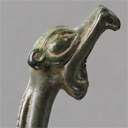0291 "Unclaimed" Artworks Entrusted to French Museums after World War II
The Case of Near Eastern Art and Antiquities
Identifiers (Article)
Abstract
Between 1949 and 1953, about 2,100 “unclaimed” artworks returned to France from Germany after World War II were selected by museum professionals and labeled MNR (Musées nationaux récupération). About half of the works are paintings, while thirty percent are decorative arts, and the remaining pieces are drawings, sculptures, folk art, Asian art, and antiquities. This paper presents the so-called AOR (Antiquités orientales récupération), 31 objects entrusted to the care of the Département des Antiquités orientales, Musée du Louvre, which at the time included both pre-Islamic and Islamic objects. Research carried out by the Mission Mattéoli (1997–2000) determined that only two, maybe three, artworks are proven to have been looted by the Einsatzstab Reichsleiter Rosenberg during the Nazi occupation of France. The rest of the AOR items were purchases made by German individuals and museums, confirming that the MNR corpus does not equate in its entirety to art plundered from Jewish collections. The study of this portion of the works is an opportunity to shed light on the Near Eastern art and antiquities market in Paris during the war.
Statistics

Supplementary Content
-
PDF (Appendix)
DescriptionCatalog entries of Antiquités orientales récupération (AOR)

License

This work is licensed under a Creative Commons Attribution-NonCommercial-NoDerivatives 4.0 International License.



